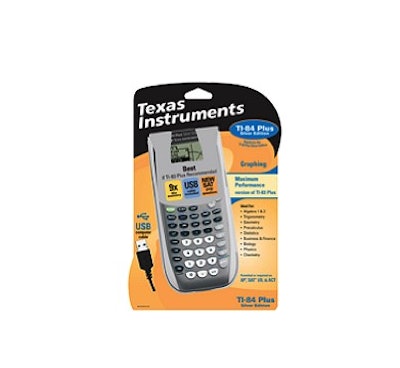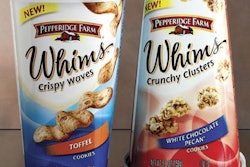
At Texas Instruments, the Educational & Productivity Solutions (E&PS) business faces the same pressure to increase sales as any of TI’s other entities. But E&PS also operates under two special constraints:
1. A key selling season takes place during a compressed time period—the back-to-school time frame—when an especially high volume of “noise” dominates retail stores.
2. The E&PS unit needs to market multiple products through the same retailer to meet differing needs of various educational curriculums and teachers.
Dallas-based TI is using packaging to meet this challenge head-on. Packaging is the cornerstone of a strategy to communicate product differentiation to customers and help them select the best product for their needs.
The approach to TI’s graphing products demonstrates how this process works. TI’s graphing products are advanced calculators with large screens and the ability to add software and upgrade operating systems. They are developed based on educator needs.
These products stay in rotation in schools for several years—longer than the average consumer electronic item. Teachers often use a specific model—from the TI-83 family, the TI-84 family, or the TI-89 family—and ask students to purchase that specific model. The model that teachers specify on their school supply list is the model they will use when teaching in the classroom.
When students and their parents visit a store to purchase the calculator, they face row upon row of graphing calculators from competing brands. Selecting the best product to meet a student’s needs can confuse consumers, who may leave the store in frustration or purchase the wrong product.
It is at this point, TI believes, that its packaging strategy guides consumers to the right product and clinches the sale.
Challenges at retail
Beyond easing consumer confusion about different products, the right package is essential in maximizing graphing calculator sales because calculator marketers are also responding to two different sets of pressures in the store. The first challenge is a short, seasonal selling window. Most graphing calculators sell in the six-week summer back-to-school period, with a small increase in sales during the first three weeks in January, when many colleges begin a new semester.
A second challenge in stores is that retailers who do volume back-to-school sales strive to keep and sell product on peg boards efficiently. The number of pegs available in a category can sometimes dip lower than a product marketer prefers.
For the back-to-school period, TI turned the challenge of having multiple products into a benefit that would help it cut through the category’s visual clutter and maximize its peg allocation. Instead of each product line having a different look, TI opted for a unified look across the entire line. “We needed to pool our products together and have a billboard effect” for the packaging to work harder in a smaller shelf set, explains Monika Mohacsi Blair, product line manager.
A package design emerges
At TI, the product line management team leads the package development process. It works directly with the company’s leadership team to make key packaging decisions. An external staffing agency provides project managers, designers, writers, and production personnel to create specific package designs. External team members work as part of TI’s package development team, which internally also includes members from both the product line management team and marketing.
One of the package development team’s first steps was to consult outside expertise. The team called on [b]Perception Research Services[n] to track consumer eye movement on shelf sets of calculators to determine which packaging factors influence product purchases. The results indicated that color is one prominent factor.
Perception Research recommended yellow as the packaging background color for TI’s graphing calculators. Consumers in the studies associated yellow with attributes such as “up-to-date” and “high tech.” The yellow background also provides a strong contrast with the generally darker colors of the calculators, notes Elizabeth Head-Fischer, package design manager.
A yellow background is also used on TI graphing calculators marketed in Australia, Latin America, and Africa. Red is used in Europe in order to differentiate from a competitor who was already using yellow.
In the United States, other colors signify extensions in the graphing calculator line. Orange card backs identify TI-84 Plus Silver Edition graphing calculators and gray or silver card backs signal the TI-83 Plus Silver Edition.
Next, the team created three package designs and tested them with consumers in eight U.S. cities. TI settled on two packaging types for the calculators. Graphing calculators and two financial calculators are packaged in 25-mil polyvinyl chloride (PVC) thermoformed clamshells from several different suppliers. Although the clamshell offers a clear view of the product, consumers also found it difficult to open, which makes it a strong theft deterrent.
Scientific and handheld calculators, and the rest of the financial calculator line, are housed in blister packs. The packages are 15-ml PVC from U.S. suppliers and PET from suppliers in the Far East.
Clamshells for the graphing calculators are generally 2 1/16” x 7 5/16” x 10 5/16”. Scientific/handheld calculator size, in blisters, measures 1/2” x 6 1/2” x 9 7/16”.
Graphics card shows ‘visual movement’
Ron Blasz, creative director, says that both color and shape play important roles in creating “visual movement” on the graphics card. Four rounded corners frame the card. An exaggerated curve at the upper right corner provides the point of entry, leading the eye to critical product information, Blasz says.
For graphing calculators, a soft Z pattern on the graphics card front leads the eye through the hierarchy of information. It starts in the upper right corner, where ovals in various colors signal different products in the line. Ovals are blue for the TI-83 Plus Graphing Calculator, mauve for the TI-84 Plus Graphing Calculator, teal for the TI-89 Advanced Graphing Calculator, and green for the TI-84 Platinum Graphing Calculator.
Below the oval, the same color repeats in a list of the calculator’s suggested uses.
The graphing calculator packaging introduces another point-of-sale tactic that’s uncommon in the product category. “Violators,” or tags, are positioned over a portion of the calculator inside the clamshell to reinforce individual product benefits.
Violators sell product differentiation
TI-84 Plus Silver Graphing Calculator packaging offers an example of how the company maximizes packaging real estate and uses awareness of its TI-83 Plus line as a springboard for the TI-84 family. Copy on the violator at the top of the calculator reads: “Best if TI-83 Plus Recommended.” Below that message, yellow, orange, and blue icons call attention to upgrades from the TI-83 Plus model.
The curved pattern’s color gradient on the graphics card becomes darker at the lower left of the card to provide a stopping point next to a die-cut in the card. The die-cut holds a USB computer cable.
Graphics cards are sheet-fed and printed offset in five colors. In the United States, [b]Pro Print[n] and [b]Allcraft Printing[n] print the cards. Overseas, TI either brokers the printing or its suppliers subcontract the work.
The board stock used for the graphics card varies between suppliers. For packaging in the United States, the material choice is often 10-point C1S board stock, but the preference in the Far East is C2S board stock. TI says board stock selection is not an important consideration, as long as the board that is used provides adequate color definition and brightness.























